Perennial flowering vines are excellent plants as gorgeous ground cover or vertical gardening. In addition to their natural beauty, flowering vines can provide extra privacy. Whether growing upward on a trellis or across a rock garden, vines provide impressive garden interest. And many of them will bloom again yearly in certain hardiness zones. So let’s look at the ten best perennial flowering vines that come back every year, plus some essential vine-growing basics.
Before you choose which vines are suitable for your garden, here are some important terms to know about how vines grow:
- Tendril vines = These vines use thin, thread-like shoots to help them attach to surfaces. Some tendril vines have leaf tendrils that grow from nodes on leaves. Other tendril vines have stem tendrils that extend from nodes on stems.
- Twining vines = These vines wrap themselves around an object with their stems.
- Aerial root vines = Vines with roots that grow above the ground use these roots to anchor themselves to surfaces. An aerial root is any root that is exposed to the air.
- Adhesive disc or hold fast vines = Some vines grow shoots with small discs covered in a natural adhesive that attaches them to surfaces. Be aware that these vines can be tough to remove and cause damage to walls, fences, and other surfaces.
- Vine training = This is the process of training or shaping vines as they grow. This process can include training vines to climb a trellis, post, or wire support or to shape them into a particular form.
Climber vs. Creeper Vines
In addition to knowing how your vine attaches itself to surfaces, you should know whether it grows up (climber) or out (creeper). Climber vines attach themselves to surfaces as they grow upward. Vines like morning glories and sweet peas are typically climbers. Other vines are creepers that grow along the ground. Beach morning glory and trumpet vines are examples of creepers.
When choosing perennial flowering vines for your garden, it’s important to consider the available space. Any garden with a lot of vertical space is ideal for climbing vines. However, for creeper vines, you’ll need plenty of space along the ground or structures low to the ground.
Note that even if you grow a climbing vine, you might need to train it to grow properly on the structures of your choice. For example, if you want a cardinal climber vine to grow on your pergola, you might tape or tie some of this twining vine’s stems to the structure to get it started. For this purpose, you’ll find that garden tape and twine are sound investments for any vine gardener!
Deciduous vs. Evergreen Vines
Knowing whether your perennial flowering vines are deciduous or evergreen will help you understand how they contribute to your garden throughout the year.
- Deciduous vines are plants that lose their leaves in winter and enter a state of dormancy. Many of these vines are herbaceous, which means they have soft non-woody stems that die back each winter. However, some deciduous vines, like wisteria, have woody stems. Even if they lose their leaves, these woody vines usually maintain above-ground growth throughout the winter.
- Evergreen vines maintain their leaves year-round. These vines are often woody and can provide structure and interest in your garden even when other plants die back for the winter.
Now that we’ve covered some vine basics let’s look at twelve of the best perennial flowering vines for your garden.
1. Allamanda Vine
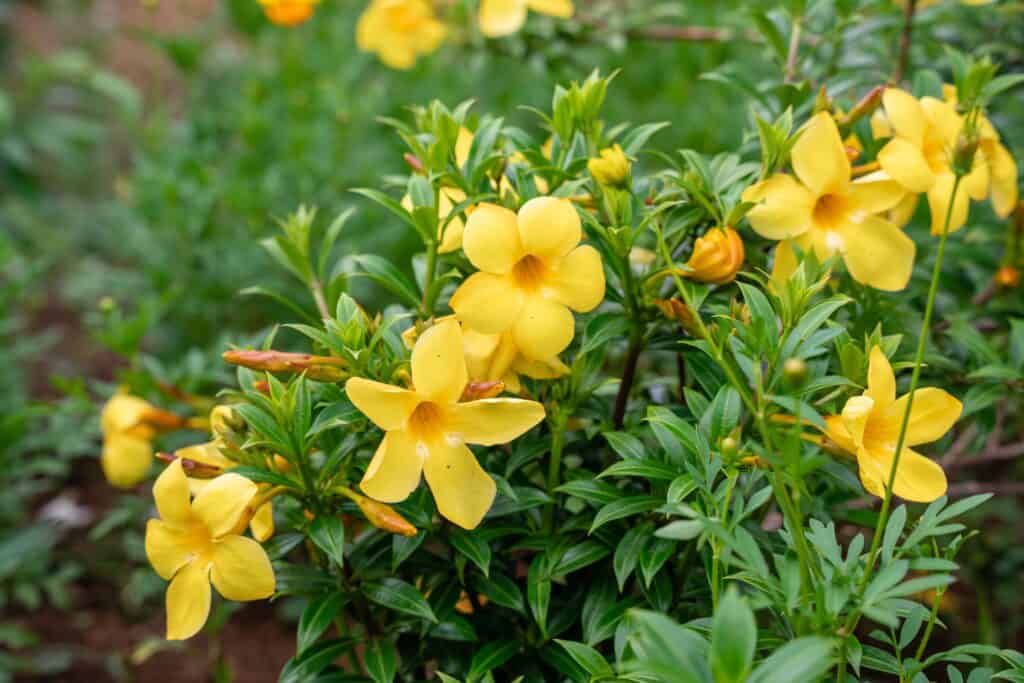
Allamanda vines are prevalent in
Florida
because they can bloom all year round in tropical and humid subtropical climates.
©Michaelnero/Shutterstock.com
Botanical name: Allamanda cathartica
Common names: golden trumpet, brown bud allamanda, allamanda vine
USDA hardiness zones: 10 to 11
Sun exposure: full sun
Mature size: up to 20 feet high, spreads up to 6 feet
Bloom time: spring to fall in most zones, all year in tropical areas
Flower colors: golden yellow
Vine type: evergreen climber
Vine attachment: No means of attachment, so needs training
The allamanda vine is a fast-growing, evergreen vine that can reach up to 20 feet tall. Allamanda has glossy, dark green leaves and large, golden-yellow flowers that bloom from spring to fall.
Allamanda vines are prevalent in Florida because they can bloom all year round in tropical and humid subtropical climates.
To grow allamanda vines, plant them in full sun in nutrient-rich and well-drained soil. Allamanda vines grow from stem cuttings or seeds. They are generally low-maintenance plants but perform best with monthly fertilizer. Additionally, they benefit from occasional pruning in late spring or early winter to keep them from getting leggy. And you can remove this vine’s seedpods to encourage more blooms.
Allamanda is grown as a vine or a shrub. To grow this flowering plant as a vine, plant it near a trellis or other airy structure it can climb. However, note that this plant does not twine or have other means of attachment. As it grows, train the allamanda vine to climb up structures by wrapping the stems around it. Or, to develop it as a shrub, prune the plant back regularly to encourage bushiness.
2. Beach Morning Glory
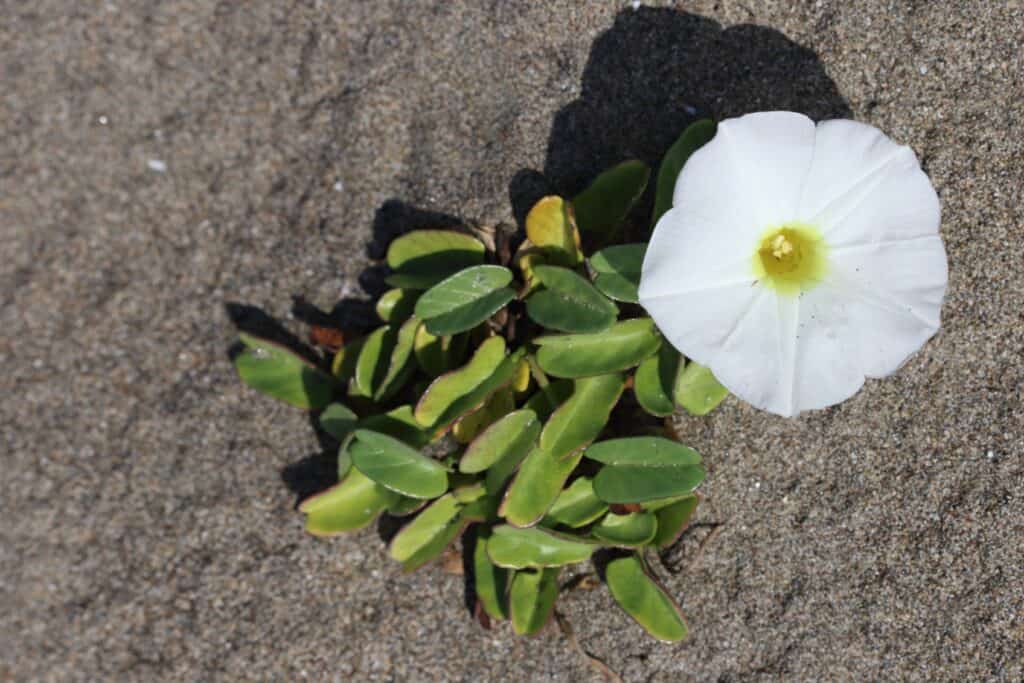
There are different varieties of beach morning glories available in different colors.
©Uunal/Shutterstock.com
Botanical name: Ipomoea imperati
Common names: morning glory, beach morning glory, railroad vine
USDA hardiness zones: 8 to 11
Sun exposure: full sun
Mature size: up to 6 inches tall, spreads up to 50 feet
Bloom time: summer through fall
Vine type: evergreen creeper
Vine attachment: aerial roots
Beach morning glory vines are hardy, fast-growing plants that thrive in coastal areas. Their love of life by the beach and salty ocean spray is why these vines are called beach morning glories. So if you want them to grow as perennial flowering vines that come back every year, grow them in zones 8-11. However, beach morning glories grow well as annual flowers in cooler zones.
There are different varieties of beach morning glories available in different colors. But Ipomoea imperati produces large white flowers that quickly cover trellises, fences, and walls with their leafy vines. Plus, their blooms are a favorite of butterflies and bees, making them great flowers for attracting pollinators.
The blooms on these showy perennial flowering vines have trumpet shapes and grow to about 2 inches across. And it’s important to note that these flowers open in the morning and then close up again by late afternoon. In addition, the plant’s foliage is medium to dark green, with leaves shaped like hearts.
Beach morning glory vines creep up to 50 feet, making them one of the longest-growing vines on our list. To grow beach morning glories, plant the seeds in well-drained soil in full sun. Once they bloom, they’ll continue to produce flowers all summer. And for colder climates, grow these vines as annuals by starting them indoors. Then transplant morning glories outside after all danger of frost has passed.
3. Black-Eyed Susan Vine
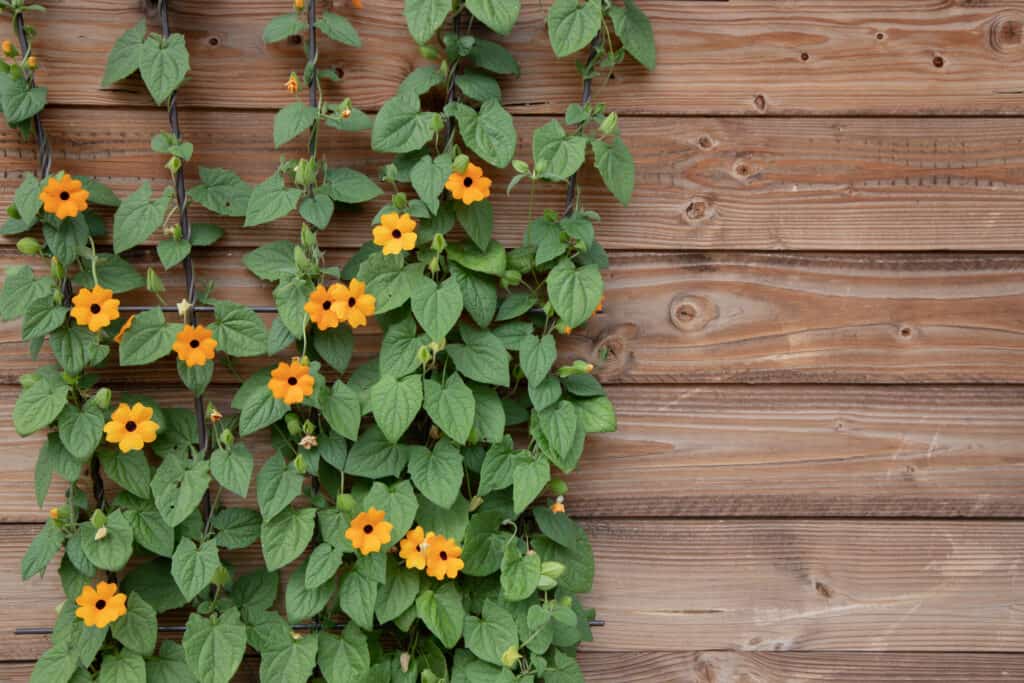
The black-eyed Susan is a fast-growing evergreen vine that can reach up to 8 feet tall with a 6-foot spread.
©Elena Medoks/Shutterstock.com
Botanical name: Thunbergia alata
Common names: black-eyed Susan vine, black-eyed clock vine,
USDA hardiness zones: 10 to 11
Sun exposure: full sun to partial sun
Mature size: up to 8 feet tall, spreading up to 6 feet
Bloom time: summer through fall
Flower colors: yellow, orange, red
Vine type: evergreen climber
Vine attachment: twining
The bright round flowers on black-eyed Susan vines are typically yellow. Still, some varieties have pink, orange, peach, or red flowers. In addition, black-eyed Susan blooms have black centers, which is how the name ‘black-eyed’ for these flowers came to be.
The black-eyed Susan is a fast-growing evergreen vine that can reach up to 8 feet tall with a 6-foot spread. Though typically grown as an annual in cooler climates, it’s a perennial flowering vine in hardiness zones 10-11.
To grow black-eyed Susan vines, plant the seeds in a sunny spot with some afternoon shade. And place them where the vines can creep up an arbor, fence, or trellis.
These vines grow best in medium-moist, well-drained soil. And they thrive in most types of soil, including clay and sand. Once the seeds have germinated, thin the seedlings until they’re about 6 inches apart. Then water them regularly and fertilize them once a month.
Black-eyed Susan vines attract hummingbirds and butterflies but, thankfully, not deer.
4. Cardinal Climber
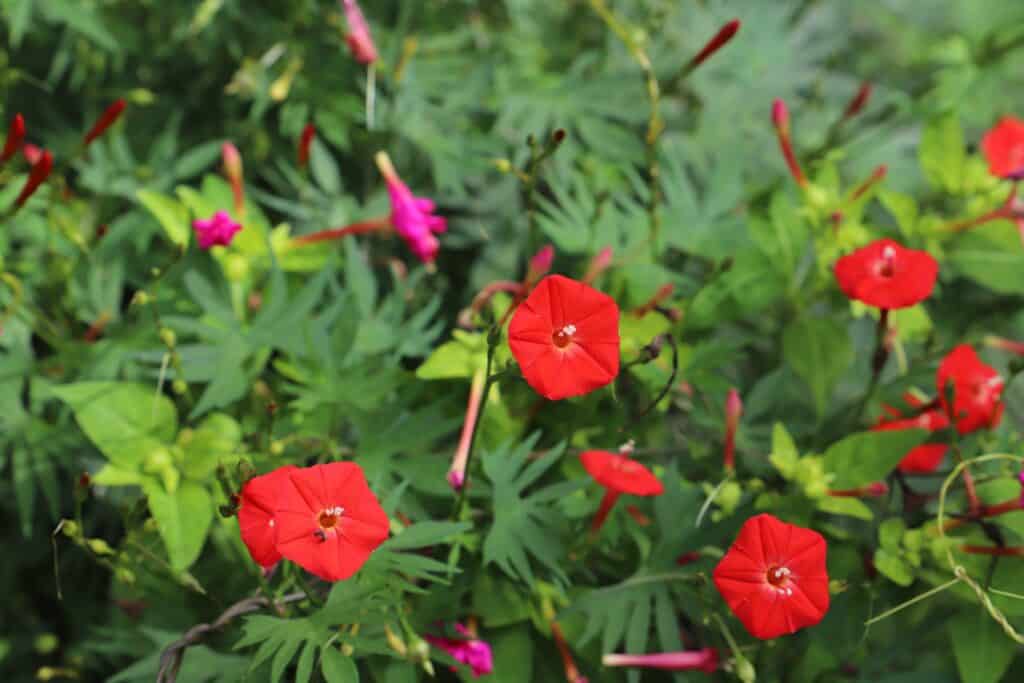
When cardinal climbers are grown as annuals, they typically reach up to 15 feet in height.
©Tasak/Shutterstock.com
Botanical name: Ipomoea quamoclit
Common names: cardinal climber, red morning glory, cypress vine, star glory
USDA hardiness zones: 11 to 12
Sun exposure: full sun
Mature size: up to 15 feet tall with a 6-foot spread
Bloom time: summer through fall
Flower colors: red
Vine type: tender evergreen climber
Vine attachment: twining
The cardinal climber vine has bright red tube-shaped flowers over thin, spikey fern-shaped leaves. The 1-inch blooms look like stars with five points, and they’re full of nectar. As a result, growing cardinal climber vines on your property will bring on the birds and the bees!
To grow a cardinal climber, start the seeds indoors about six weeks before the last frost date. Plant this evergreen vine in a sunny spot with well-drained soil, and water them regularly.
When cardinal climbers are grown as annuals, they typically reach up to 15 feet in height. But if you live in hardiness zones 11 or 12, they will come back every year and can get even taller! This climbing vine is a self-seeder but not considered invasive in most hardiness zones of the US.
One of the best things about these vines is that they don’t need to be pruned and are not at risk for many pests or diseases. So you can enjoy their beautiful blooms summer through fall without having to rescue them from itty bitty predators.
However, be careful with vines that don’t attract pests because it might mean they’re toxic to animals. Unfortunately, this is the case with cardinal creepers. So don’t let your pets chew on cardinal creeper plants, as they are toxic for cats, dogs, and horses.
5. Clematis
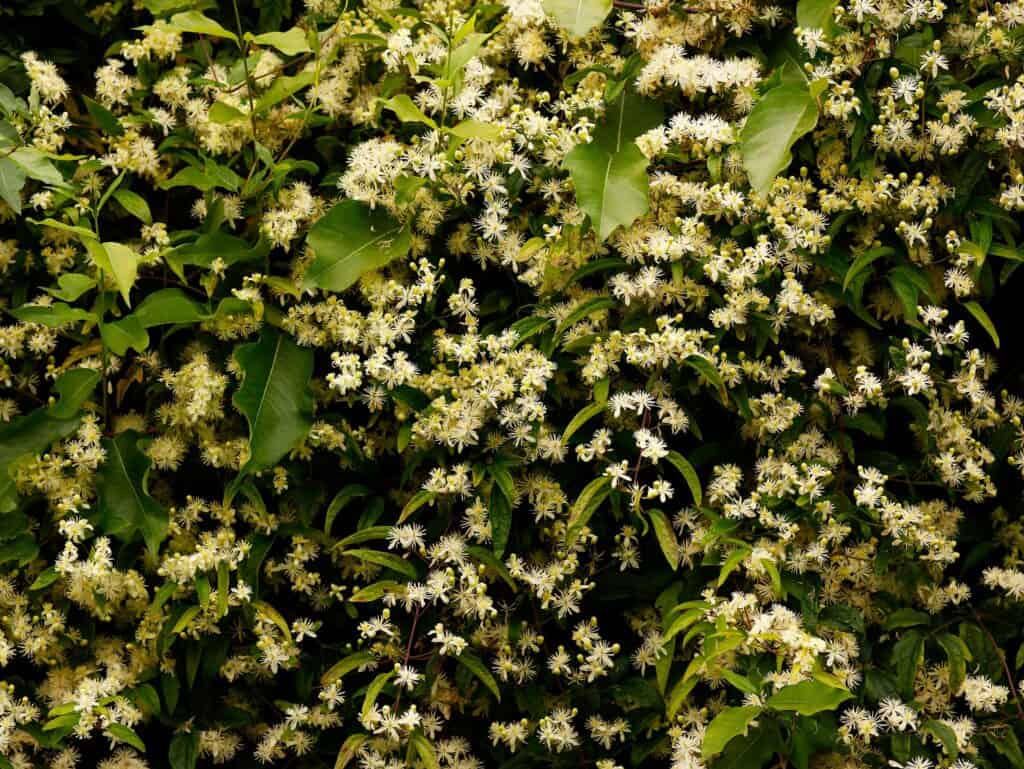
Plant your clematis vines in a sunny spot with some afternoon shade for the best performance.
©Joe Kuis/Shutterstock.com
Botanical name: Clematis virginiana
Common names: leather flower, virgin’s bower, old man’s beard
USDA hardiness zones: 3 to 9
Sun exposure: full to partial sun
Mature size: up to 20 feet tall with a 6-foot spread
Bloom time: summer through fall
Flower colors: white
Vine type: deciduous climber
Vine attachment: twining
Clematis is a fragrant climbing vine that’s easy to grow. It produces many tiny delicate blooms in a variety of colors. Though the flowers of our featured plant – the Clematis virginiana – are usually white. And a unique feature of this clematis is how the female flowers turn to dark seed heads with long fluffy plumes. These funky seed heads with their wild hairdos look straight out of a Dr. Seuss book! And that’s part of the fun of growing this extraordinary vine in your home garden.
Plant your clematis vines in a sunny spot with some afternoon shade for the best performance. And note that clematis plants like rich, well-drained soil high in organic matter. So add compost or manure to the hole in their soil before planting.
Fertilize clematis vines once a month with a balanced fertilizer. And if you want them to climb higher, provide them with a trellis or some other type of support.
Clematis vines are deciduous, which means they will lose their leaves in the fall. But don’t worry; these perennial flowering vines come back bigger and better the following spring.
6. Honeysuckle

Honeysuckle is a deciduous vine that will lose its leaves in the fall.
©Aftabbanoori / Creative Commons – License
Botanical name: Lonicera japonica
Common names: Japanese honeysuckle, honeysuckle
USDA hardiness zones: 4 to 9
Sun exposure: full sun to partial shade
Mature size: up to 30 feet tall with a 6-foot spread
Bloom time: summer through fall
Flower colors: white to yellow
Vine type: deciduous climber
Vine attachment: twining
Honeysuckle is a fast-growing vine that produces clusters of fragrant flowers from summer to fall. This vine’s tubular flowers with long stamens start white and turn yellow as they age. And then it produces small black berries that birds like finches and robins.
Unfortunately, this vine is one of the perennial flowering vines considered invasive in some areas. So make sure to check local planting guidelines before planting it. If you decide to grow honeysuckle, give it plenty of space to roam because it can take over an area quickly. Plant honeysuckle in full sun to partial shade, and provide it with a trellis or some other type of support to twine around.
Honeysuckle is a deciduous vine that will lose its leaves in the fall. But this perennial vine will spring to life again next year in hardiness zones 4 through 9.
However, this plant will only thrive if garden pests like aphids and thrips don’t gnaw this vine to death. Or it doesn’t succumb to a nasty case of powdery mildew. So, ensure the health of your honeysuckle vines by watching for signs of pests and diseases.
7. Passion Flower
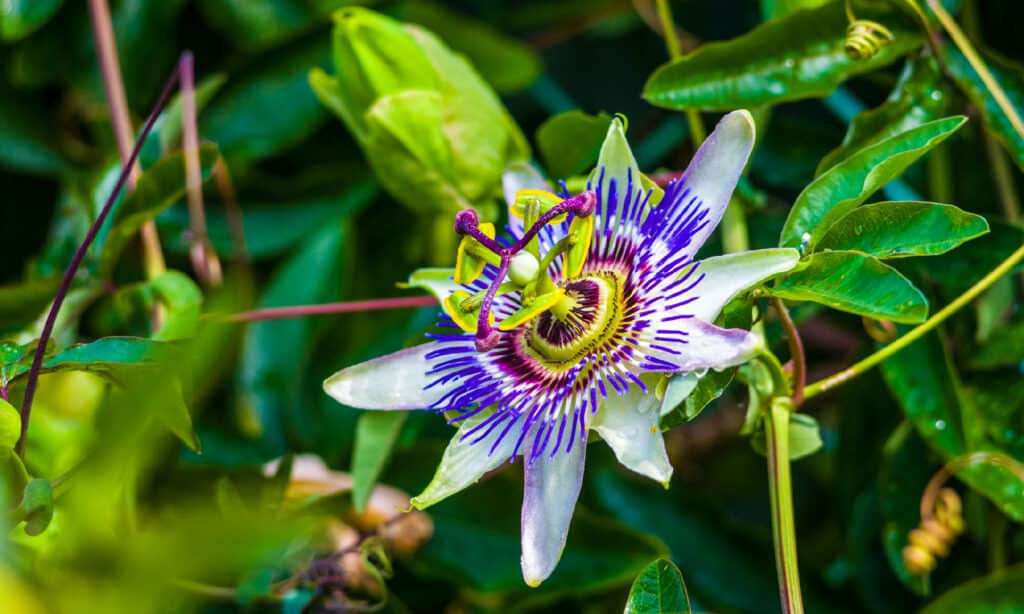
Passion flower is a deciduous vine.
©iStock.com/Shedu
Botanical name: Passiflora incarnata
Common names: maypop, purple passion flower, wild passion flower
USDA hardiness zones: 6 to 10
Sun exposure: full sun to partial shade
Mature size: up to 20 feet tall with a 12-foot spread
Bloom time: summer through fall
Flower colors: white to purple
Vine type: deciduous climber
Vine attachment: tendrils
Passion flower (or passionflower, depending on the source) is a droopy climbing vine with large exotic-looking flowers. Its unique blooms have white petals with purple and blue accents that look like curly tendrils. And the passion flower’s attractive blooms are a favorite of many pollinators, including hummingbirds, bees, and butterflies.
This beautiful plant is one of the best perennial flowering vines for hot summer climates. So if you live in a warm region, this could be the perfect vine for your garden. But no matter where you plant it, your passion flower vine needs full sun to partial shade. And it will perform better if you scatter some mulch around its roots at planting.
Passion flower is a deciduous vine. So it will shed leaves in the fall but grow them back again if you live within hardiness zones 6 to 10. And be sure to give it some winter protection if you live in an area with cold winters. You can do so by adding leafy much around the base of the plants.
8. Perennial Sweet Pea
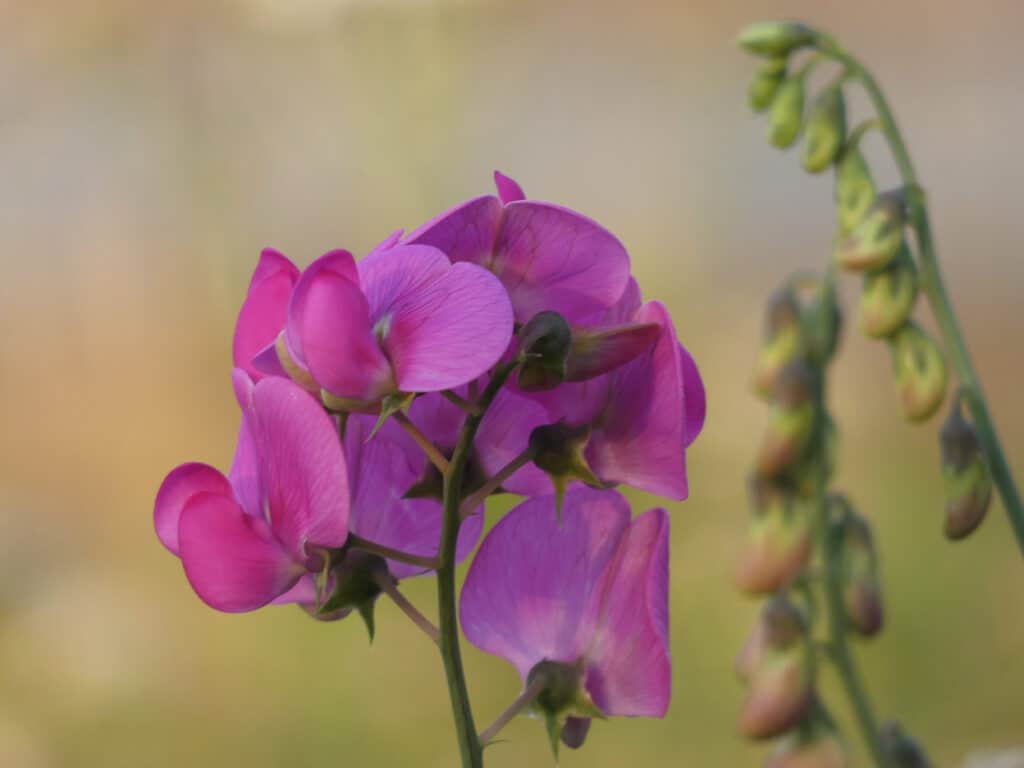
This flowering vine is invasive in some areas of the US because it’s a masterful self-seeder.
©Slawinka/Shutterstock.com
Botanical name: Lathyrus latifolius
Common names: everlasting pea, perennial sweet pea, hardy sweet pea
USDA hardiness zones: 5 to 9
Sun exposure: full to partial sun
Mature size: up to 10 feet tall with a 6-foot spread
Bloom time: summer to fall
Flower colors: pink, purple, white
Vine type: deciduous climber
Vine attachment: tendrils
The perennial sweet pea vine is a climbing vine that produces rows of pea-shaped flowers in shades of pink, purple, and white. These fancy delicate blooms also look similar to orchids, only smaller. Unlike other sweet pea plants, the perennial sweet pea isn’t fragrant. But it does attract bees and butterflies. This vine also produces tiny black seeds that finches and sparrows enjoy.
This flowering vine is invasive in some areas of the US because it’s a masterful self-seeder. So check for local planting restrictions before growing a perennial sweet pea in your home garden.
The perennial sweet pea vine is a fast-growing plant and easy to grow from seed. And it’s a beautiful flowering vine for sunny areas. So if you have a spot in your garden that gets six to eight hours of sunlight per day, this would be a good choice. Though this vine also does well in partially shady areas, it won’t bloom as profusely.
9. Trumpet Creeper

If you decide to grow a trumpet creeper vine, give it plenty of space to roam because it can take over an area quickly.
©iStock.com/Michel VIARD
Botanical name: Campsis radicans
Common names: trumpet vine, cow vine, foxglove vine
USDA hardiness zones: 5 to 9
Sun exposure: full to partial sun
Mature size: up to 40 feet tall with a 10-foot spread
Bloom time: summer
Flower colors: red, orange, or yellow
Vine type: deciduous climber
Vine attachment: tendrils and aerial rootlets
The trumpet creeper is a fast-growing climber vine. It produces beautiful clusters of trumpet-shaped flowers in red, orange, and yellow. This vine’s stunning blooms are narrow, with a long funnel-shaped base adored by hummingbirds.
This vine with bright blooms is one of the best perennial flowering vines for covering a fence or trellis. But be warned: trumpet creeper vines are invasive in some areas. So before you buy one, check local laws for any planting restrictions.
If you decide to grow a trumpet creeper vine, give it plenty of space to roam because it can take over an area quickly. Plant it in full sun, and provide it with a trellis, fence, or some other type of support to twine around.
Trumpet creeper is deciduous, so it will drop its leaves in autumn. But this perennial vine will spring to life again next year in hardiness zones 5 through 9.
10. Wisteria
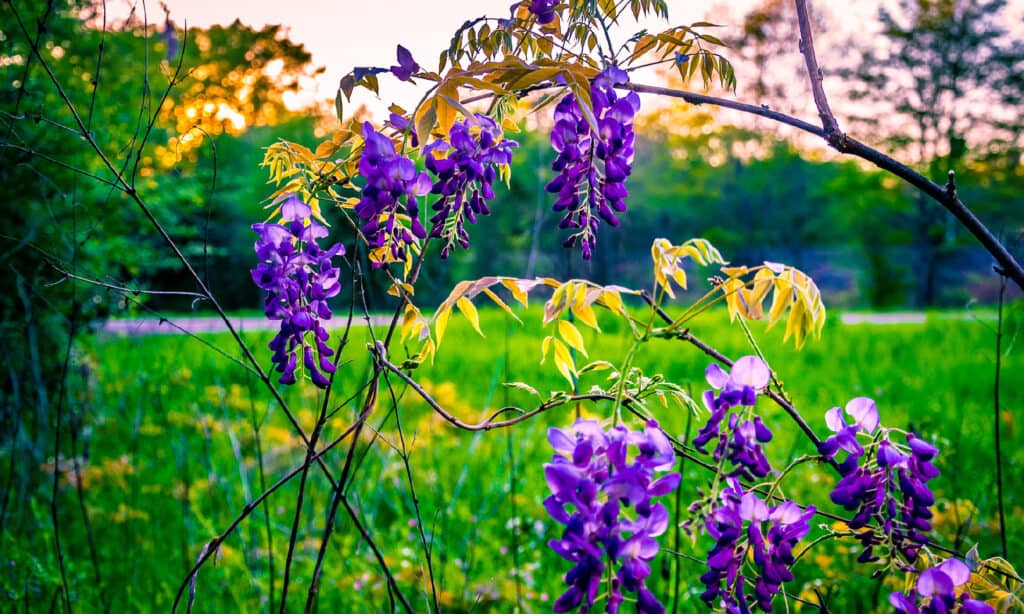
Wisteria is a fast-growing twining vine that provides garden interest from spring through summer.
©iStock.com/Steve Shubert
Botanical name: Wisteria sinensis
Common names: Chinese wisteria, silky wisteria
USDA hardiness zones: 5 to 9
Sun exposure: full to partial sun
Mature size: up to 40 feet tall with a 30-foot spread
Bloom time: late spring to early summer
Flower colors: blue, lavender, pink, white
Vine type: deciduous climber
Vine attachment: twining
Wisteria is a beautiful perennial flowering vine with long loose-hanging clusters of fragrant blue, lavender, pink, or white flowers. This climbing vine looks like it’s covered with drooping lilac blooms and smells just as sweet. Wisteria blooms in the spring and has beautiful green foliage that turns yellow in the fall.
We couldn’t think of a more romantic-looking flowering vine to close our list! Though it comes last alphabetically, beautiful wisteria should be at the top of every list of best perennial flowering vines. Would you agree?
Wisteria is a fast-growing twining vine that provides garden interest from spring through summer. First, they romance you with their soft cluster flowers with many dainty petals. Then, they delight you by dangling their long velvety seed pods in the breeze, like nature’s windchimes in green and brown.
To grow a healthy wisteria plant, give it full sun and well-drained soil. Prune this vine regularly, or it will take over. And it’s also important to provide this vine with a supportive structure like a trellis. Unfortunately, as a deciduous plant, wisteria will drop its leaves in the fall. But it will live to dazzle again next spring in hardiness zones 5 to 9.
The best perennial flowering vines are waiting for you!
Are you excited to grow one or more of these incredible flowering vines? Knowing how each vine grows and attaches to surfaces is key to getting started. Get climbing vines for vertical spaces and creepers for trailing along the ground. And don’t forget to train any vines that need extra support clinging to your fences, arbors, and other garden structures. Soon you’ll enjoy the rewards of planting the best perennial flowering vines that come back every year!
Up Next:
Vines in Texas: Vines Found Across the Lonestar State
Is Hibiscus a Perennial or Annual?
15 Best Potted Annual Flowers to Attract Pollinators
The photo featured at the top of this post is © Elena Medoks/Shutterstock.com
Sources
- Almanac, Available here: https://www.almanac.com/plant/wisteria
- ILLINOIS COLLEGE OF LIBERAL ARTS & SCIENCES, Available here: https://www.life.illinois.edu/help/digitalflowers/Vegetative/16.htm#:~:text=A%20vine%20is%20a%20woody,that%20it%20cannot%20support%20itself.
- Fairfax County, Available here: https://www.fairfaxcounty.gov/parks/sites/parks/files/assets/documents/nature-history/greenspring/infosheets/vines.pdf
Thank you for reading! Have some feedback for us? Contact the AZ Animals editorial team.






